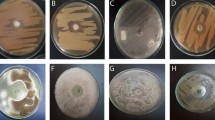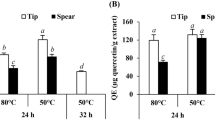Abstract
Spa resorts are known for thousands of years for their healing properties and have been empirically used for the treatment of many inflammatory conditions. Mud is one of the most often used natural materials for preventive, healing and cosmetic reasons and although it has been used since the antiquity, little light has been shed on its physical, chemical and biological properties. In this study we examined the effect of mud extracts on the expression of adhesion molecules (CAMs) by endothelial cells as well as their effects on monocyte adhesion to activated endothelial cells. Most of mud extracts inhibited the expression of VCAM-1 by endothelial cells and reduced monocyte adhesion to activated endothelial cells, indicating a potent anti-inflammatory activity. Furthermore, the mud extracts were tested for their antimicrobial activity; however, most of them appeared inactive against S. aureus and S. epidermidis. One of the mud extracts (showing the best stabilization features) increased significantly the expression of genes involved in cell protection, longevity and hydration of human keratinocytes, such as, collagen 6A1, forkhead box O3, sirtuin-1, superoxide dismutase 1 and aquaporin-3. The present study reveals that mud exerts important beneficial effects including anti-inflammatory and anti-aging activity as well as moisturizing effects, implicating important cosmeceutical applications.





Similar content being viewed by others
Abbreviations
- AD:
-
Atopic dermatitis
- AQP3:
-
Aquaporin-3
- Col6A1:
-
Collagen 6A1
- FOXO3:
-
Forkhead box
- HAEC:
-
Human aortic endothelial cells
- ICAM:
-
Intracellular adhesion molecule
- VCAM:
-
Vascular cell adhesion molecule
- MTT:
-
3-(4,5-Dimethylthiazol-2-yl)-2,5-diphenyl tetrazolium bromide
- SIRT1:
-
Sirtuin-1
- SOD1:
-
Superoxide dismutase
- TNF:
-
Tumor necrosis factor
- αΤ3:
-
α-Tocotrienol
- BCECF-AM:
-
20,70-Bis-(2-carboxyethyl)-5-(and-6)-carboxy-fluorescein acetoxymethyl ester
References
Boury-Jamot, M., Daraspe, J., Bonté, F., Perrier, E., Schnebert, S., Dumas, M., et al. (2009). Skin aquaporins: Function in hydration, wound healing, and skin epidermis homeostasis. Handbook of Experimental Pharmacology, 190, 205–217.
Braydich-Stolle, L. K., Lucas, B., Schrand, A., Murdock, R. C., Lee, T., Schlager, J. J., et al. (2010). Silver nanoparticles disrupt GDNF/Fyn kinase signaling in spermatogonial stem cells. Toxicological Sciences, 116(2), 577–589.
Cozzi, F., Carrara, M., Sfriso, P., Todesco, S., & Cima, L. (2004). Anti-inflammatory effect of mud-bath applications on adjuvant arthritis in rats. Clinical and Experimental Rheumatology, 22(6), 763–766.
Crouch, S. P., Kozlowski, R., Slater, K. J., & Fletcher, J. (1993). The use of ATP bioluminescence as a measure of cell proliferation and cytotoxicity. Journal of Immunological Methods, 160(1), 81–88.
Curri, S. B., Bombardelli, E., & Grossi, F. (1997). Observations on organic components of thermal mud: Morphohistochemical and biochemical studies on lipid components of mud of the Terme dei Papi (Laghetto del Bagnaccio, Viterbo). Chemical bases of the interpretation of biological and therapeutic actions of thermal mud. Clinica Terapeutica, 148(12), 637–654.
Damianakos, H., Kretschmer, N., Sykłowska-Baranek, K., Pietrosiuk, A., Bauer, R., & Chinou, I. (2012). Antimicrobial and cytotoxic isohexenylnaphthazarins from Arnebia euchromia (Royle) Jonst (Boraginaceae) callus and cell suspension culture. Molecules, 17, 14310–14322.
Deters, A. M., Schröder, K. R., & Hensel, A. (2005). Kiwi fruit (Actinidia chinensis L.) polysaccharides exert stimulating effects on cell proliferation via enhanced growth factor receptors, energy production, and collagen synthesis of human keratinocytes, fibroblasts, and skin equivalents. Journal of Cellular Physiology, 202, 717–722.
Fioravanti, A., Cantarini, L., Guidelli, G. M., & Galeazzi, M. (2011). Mechanisms of action of spa therapies in rheumatic diseases: What scientific evidence is there? Rheumatology International, 31(1), 1–8.
Giacomino, M. I., & de Michele, D. F. (2007). Is mud an anti-inflammatory? Anales de Medicina Interna, 24(7), 352–353.
Hara-Chikuma, M., & Verkman, A. S. (2008). Roles of aquaporin-3 in the epidermis. Journal of Investigative Dermatology, 128(9), 2145–2151.
Hubbard, B. P., & Sinclair, D. A. (2014). Small molecule SIRT1 activators for the treatment of aging and age-related diseases. Trends in Pharmacological Sciences, 35, 146–154.
Jung, K., Linse, F., Heller, R., Moths, C., Goebel, R., & Neumann, C. (1996). Adhesion molecules in atopic dermatitis: VCAM-1 and ICAM-1 expression is increased in healthy-appearing skin. Allergy, 51(7), 452–460.
Makrantonaki, E., & Zouboulis, C. C. (2007). Molecular mechanisms of skin aging: State of the art. Annals of the New York Academy of Sciences, 1119, 40–50.
Mestas, J., & Ley, K. (2008). Monocyte-endothelial cell interactions in the development of atherosclerosis. Trends in Cardiovascular Medicine, 18(6), 228–232.
Odabasi, E., Gul, H., Macit, E., Turan, M., & Yildiz, O. (2007). Lipophilic components of different therapeutic mud species. Journal of Alternative and Complementary Medicine, 13(10), 1115–1118.
Portugal-Cohen, M., Soroka, Y., Ma’or, Z., Oron, M., Zioni, T., Brégégère, F. M., et al. (2009). Protective effects of a cream containing Dead Sea minerals against UVB-induced stress in human skin. Experimental Dermatology, 18(9), 781–788.
Ramakers, C., Ruijter, J. M., Deprez, R. H., & Moorman, A. F. (2003). Assumption-free analysis of quantitative real-time polymerase chain reaction (PCR) data. Neuroscience Letters, 339(1), 62–66.
Rimmelé, P., Bigarella, C. L., Liang, R., Izac, B., Dieguez-Gonzalez, R., Barbet, G., et al. (2014). Aging-like phenotype and defective lineage specification in SIRT1-deleted hematopoietic stem and progenitor cells. Stem Cell Reports, 3, 44–59.
Rosas-Hernández, H., Jiménez-Badillo, S., Martínez-Cuevas, P. P., Gracia-Espino, E., Terrones, H., Terrones, M., et al. (2009). Effects of 45-nm silver nanoparticles on coronary endothelial cells and isolated rat aortic rings. Toxicology Letters, 191(2–3), 305–313.
Sigurdsson, V., de Vries, I. J., Toonstra, J., Bihari, I. C., Thepen, T., Bruijnzeel-Koomen, C. A., et al. (2000). Expression of VCAM-1, ICAM-1, E-selectin, and Pselectin on endothelium in situ in patients with erythroderma, mycosis fungoides and atopic dermatitis. Journal of Cutaneous Pathology, 27, 436–440.
Stefani, M., Markus, M. A., Lin, R. C., Pinese, M., Dawes, I. W., & Morris, B. J. (2007). The effect of resveratrol on a cell model of human aging. Annals of the New York Academy of Sciences, 1114, 407–418.
Steinhoff, M., Steinhoff, A., Homey, B., Luger, T. A., & Schneider, S. W. (2006). Role of vasculature in atopic dermatitis. Journal of Allergy and Clinical Immunology, 118(1), 190–197.
Tamaki, K., & Nakamura, K. (2001). The role of lymphocytes in healthy and eczematous skin. Current opinion in Allergy and Clinical Immunology, 1, 455–460.
Theriault, A., Chao, J. T., & Gapor, A. (2002). Tocotrienol is the most effective vitamin E for reducing endothelial expression of adhesion molecules and adhesion to monocytes. Atherosclerosis, 160, 21–30.
Trickler, W. J., Lantz-McPeak, S. M., Robinson, B. L., Paule, M. G., Slikker, W, Jr., Biris, A. S., et al. (2014). Porcine brain microvessel endothelial cells show pro-inflammatory response to the size and composition of metallic nanoparticles. Drug Metabolism Reviews, 46(2), 224–231.
van der Wal, A. C., Das, P. K., Tigges, A. J., & Becker, A. E. (1992). Adhesion molecules on the endothelium and mononuclear cells in human atherosclerotic lesions. American Journal of Pathology, 141(6), 1427–1433.
Verdier-Sévrain, S. (2007). Effect of estrogens on skin aging and the potential role of selective estrogen receptor modulators. Climacteric, 10(4), 289–297.
Waterman, P. G., & Mole, S. (1994). Analysis of phenolic plant metabolites. In J. H. Lawton & G. E. Likens (Eds.), Methods in ecology. Oxford: Blackwell Scientific Publications.
Zagklis, D. P., Vavouraki, A. I., Kornaros, M. E., & Paraskeva, C. A. (2015). Purification of olive mill wastewater phenols through membrane filtration and resin adsorption/desorption. Journal of Hazardous Materials, 285, 69–76.
Zajdel, S. M., Graikou, K., Sotiroudis, G., Głowniak, K., & Chinou, I. (2013). Two new iridoids from selected Penstemon species—Antimicrobial activity. Natural Product Research, 27(24), 2263–2271.
Acknowledgments
We thank the Greek Secretariat of Research and Technology, Greek Ministry of Education and Religion (ISR_3163) in cooperation with the company Apivita S.A. We also thank Mr. Georgio Georgiadi from the company Physis & Ousia for providing the mud samples from Messologi and Ms. Liora Chilron from the company Anna Lotan for providing the mud sample from Israel that greatly assisted our research.
Author information
Authors and Affiliations
Corresponding author
Ethics declarations
Conflict of interest
The authors declare that there is no conflict of interest.
Additional information
Eliana Spilioti and Margarita Vargiami have contributed equally to this work.
Electronic supplementary material
Below is the link to the electronic supplementary material.
Rights and permissions
About this article
Cite this article
Spilioti, E., Vargiami, M., Letsiou, S. et al. Biological properties of mud extracts derived from various spa resorts. Environ Geochem Health 39, 821–833 (2017). https://doi.org/10.1007/s10653-016-9852-y
Received:
Accepted:
Published:
Issue Date:
DOI: https://doi.org/10.1007/s10653-016-9852-y




